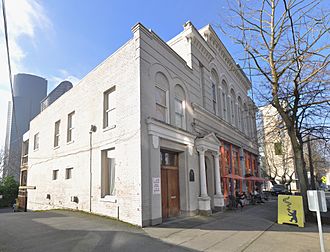German House (Seattle) facts for kids
Quick facts for kids German House |
|
|---|---|

German House in 2013 (featuring the recently opened Kafe Berlin)
|
|
| Former names | Assay Office |
| Alternative names | German Club |
| General information | |
| Location | 613 9th Ave Seattle, Washington, U.S. |
| Completed | 1893 |
| Designated: | July 6, 1983 |
|
Assay Office
|
|
| Built | 1893 |
| Architect | John B. Parkinson |
| Architectural style | Romanesque Revival, Beaux Arts |
| NRHP reference No. | 72001271 |
| Added to NRHP | March 16, 1972 |
The German House is a special building in the First Hill area of Seattle, Washington. It's also known as the Assay Office or Prosch Hall. Built in 1893, this building has had many different jobs! It started as an office and an entertainment hall. Until 1932, it was the city's assay office. This is where most of the gold from the Klondike Gold Rush was processed into bricks.
After World War II, the building went back to its previous German-American owners. Today, it's still a popular place for German-themed events in Seattle. It was named a Seattle Landmark in 1983. It was also added to the National Register of Historic Places as the Assay Office in 1972.
History of the German House
Early Days and the Gold Rush
The story of the German House began in 1893. A local newspaper publisher named Thomas W. Prosch hired architect John B. Parkinson. Prosch wanted a two-story brick building with a basement. It would have two shops on the ground floor and a public hall upstairs. This hall was known as Prosch Hall.
Prosch also collected photos and wrote books about the Puget Sound area. Soon, lots of gold was expected to arrive in Seattle from the Yukon gold fields. The government needed a special building for an assay office. An assay office is where gold nuggets and flakes are tested and then molded into bricks. These bricks would then be sent to the mint in San Francisco.
In June 1898, Prosch leased his entire building to the government. It would be used as the assay office and mint. Fred A. Wing was chosen to open and run the new facility. However, members of the Westminster Presbyterian Church still had a lease for the upstairs hall. They were not happy about the deal.
The church members barricaded themselves inside the building. They threatened legal action against Prosch and the workers. The government needed the office to open on time. So, Prosch quickly met the church's demands to get them to leave. The standoff lasted only one day. Remodeling could then continue for the July 15 opening date.
By the next year, this assay office was processing more gold than any other in the United States. Later, a vault room was added to the south side of the building. This was in the early 1900s. It was later built up into the small two-story annex you can see today.
A Center for German Culture
By the late 1920s, the amount of gold being brought in had dropped a lot. In 1932, the building stopped being used as an assay office. In 1935, a group called Deutsches Haus (German Club) took over the building. This organization was for Seattleites of German descent. The building became their social center.
During World War II, the building was used by the Navy as an entertainment center. After the war, it returned to its German owners. Today, the German Heritage Society in Seattle manages the building. It hosts many different German activities. These include traditional concerts and balls. Lectures about the building's history have also taken place here.
On July 6, 1983, the city of Seattle's Landmark Preservation Board named German House a Seattle Landmark. It had already been added to the National Register of Historic Places in March 1972.
In November 2011, a German-themed café called "Kafé Berlin" opened on the first floor. However, it closed permanently by 2016.


